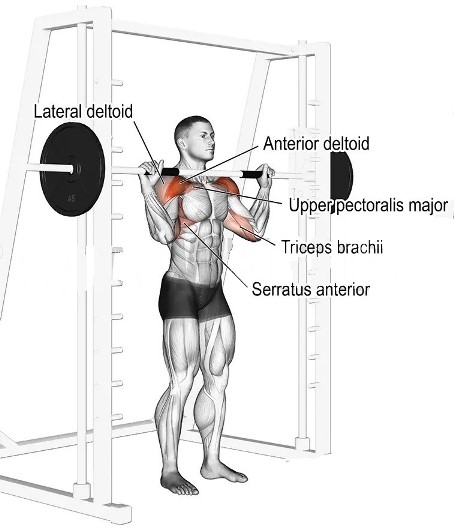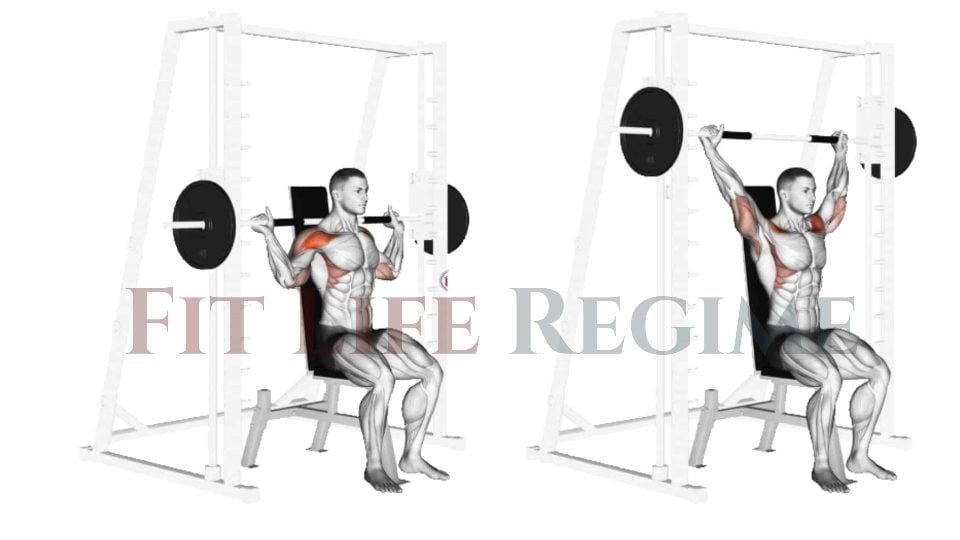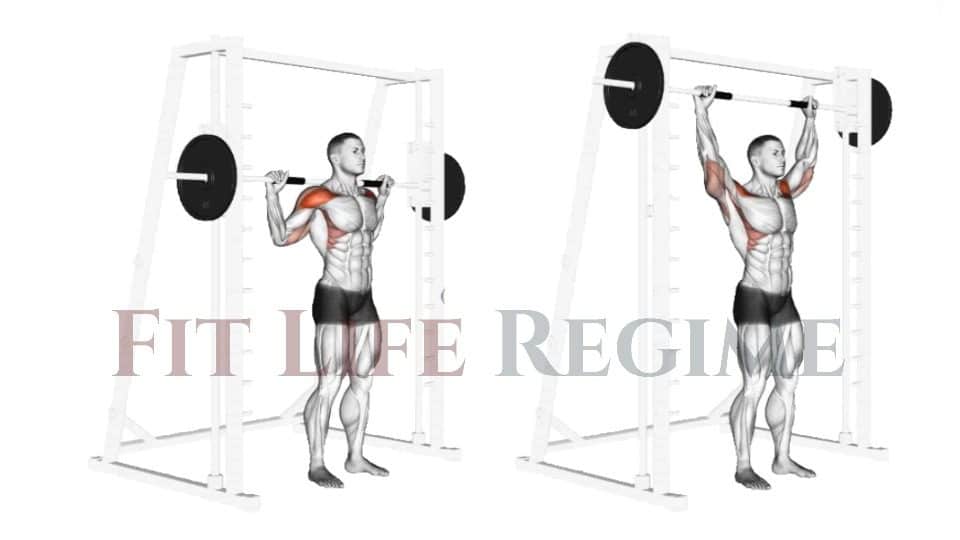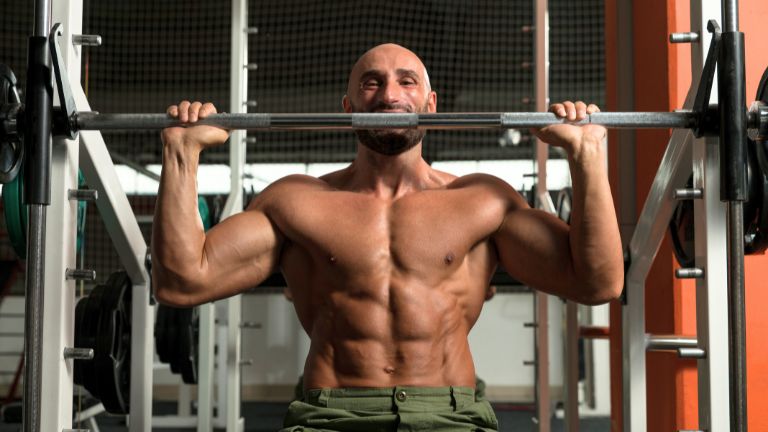The Smith machine shoulder press is a popular shoulder (Deltoid) exercise among bodybuilders because it helps build muscle quickly.
Some lifters prefer the Smith press over the barbell press because it provides extra shoulder joint safety, promoting heavier lifts.
It specifically trains the front part of the shoulder (anterior deltoid), but you will also use some lateral delts, traps, and triceps.
It consists of a barbell fixed within steel rails that allows for sound and stable vertical movement.
The bar path is fixed, so the machine stabilizes the weight and reduces the need for extra balance and stabilization from smaller muscle groups.
The Smith machine also helps beginners learn how to move their shoulders by giving them a stable range of motion.

- Smith Machine Shoulder Press Muscles Worked
- How To Do Smith Machine Seated Shoulder Press
- Proper Form and Tips
- Sets and Reps
- Smith Machine Shoulder Press Variations
- 1. Standing Smith Machine Shoulder Press
- 2. Seated Smith Machine Behind The Neck Shoulder Press
- 3. Standing Smith Machine Behind The Neck Shoulder Press
- Benefit Of Doing Shoulder Press With Smith Machine
- 1. Stability and Safety
- 2. Effective Isolate Shoulder Muscles
- 3. Consistent Overload
- 4. Better for Training Alone
- 5. Build Shoulder Mass and Strength
- 6. Improved Safety
- FAQs
- Free Weight Press Vs. Smith Machine Shoulder Press
- References
Smith Machine Shoulder Press Muscles Worked
The Smith machine shoulder press primarily targets the shoulder muscles. When performed with proper technique, it works all three heads of the delts:
- Primarily Muscles: Anterior Deltoid, Lateral Deltoid, Rear Delt
In addition to the shoulder muscles, the Smith press also activates these secondary muscle groups:
- Triceps Brachii: Assist pressing motion and elbow extension.
- Upper Chest: Helps press barbell overhead.
- Trapezius: Provides neck and shoulder stability during overhead presses.
A handful of other muscles worked or play the role of stabilizer muscles during overhead standing smith machine press, including you,
- Wrist flexors,
- Obliques, and
- Rectus abdominis.
- Serratus Anterior
- Supraspinatus,

How To Do Smith Machine Seated Shoulder Press
- Place a flat or adjustable bench beneath the Smith Machine. If the bench is adjustable, set it to an upright position.
- Sit on the bench with your back straight and feet flat on the floor.
- Your head and neck should be neutral, and your back should be against the bench’s backrest.
- Place both hands on the bar with an overhand grip (palms facing away from your body), slightly wider than your shoulders.
- Lift the barbell off the rack by rotating your wrists to unlock it.
- Slowly lower the barbell down towards your shoulders. Keep your elbows pointed out to the sides, not forward.
- Lower the bar until it’s slightly above or touching the top of your shoulders.
- Press the bar back up to the starting position, extending your arms fully but not locking your elbows.
- Perform the desired number of repetitions and sets according to your workout plan.
- After completing a set, safely lock the bar back onto the rack.
Proper Form and Tips
- If you are new to the exercise, you can start with a lighter weight. Perform a warm-up with 50% weight for 1–2 sets.
- Make sure your grip is firm, and your wrists are straight.
- The bar should be aligned with your shoulders, not too far forward or back.
- Your elbows should point slightly forward, not directly to the sides.
- Don’t arch back or overextend — keep an upright spinal alignment.
- Avoid flaring elbows too far out. Keep upper arm by ears.
- Avoid letting the bar drop quickly, which can shake up the muscles and joints.
- Avoid locking your elbows at the top of the movement to maintain tension on the shoulder muscles.
- Keep your movements controlled, especially when lowering the bar.
- Inhale as you lower the bar towards your shoulders. Exhale as you press the bar upwards.
- Ensure the barbell on the Smith Machine is set at a height that you can comfortably reach when seated.
- Always perform the Shoulder exercises before you perform the triceps workout.
- Your hands should be slightly wider than shoulder-width apart. A too-narrow grip can overly stress your triceps, and a too-wide grip can strain your shoulder joints.
- Cool down after doing this exercise to help your muscles recover.
Sets and Reps
- For muscle growth, it is best to do 6–12 reps per set and take 45–60 seconds of rest between sets.
- For strength, it is recommended that you do 3–8 reps per set and take 60–90 seconds of rest between sets.
- To build muscle endurance, do 15-20+ reps per set, and rest for 30–45 seconds between sets.
Smith Machine Shoulder Press Variations
Try this variation if you’re tired of doing shoulder presses on the Smith Machine or want to add variety to your next upper-body workout.
1. Standing Smith Machine Shoulder Press
The Smith Machine standing overhead press is a compound exercise that effectively builds size for the entire shoulder complex and also helps strengthen the core muscles.
Standing up while doing the press requires more work from your core and stabilizer muscles to stay balanced and in control.
It is a safer alternative to the traditional standing shoulder press because you do not have to stabilize the weight as much.
How To Do
- Stand in the Smith Machine with feet shoulder-width apart for stability.
- Stand under the bar and use a pronated grip that is a little wider than the shoulder width.
- Don’t look up; keep your body still and your head facing forward
- Begin with the bar at about the height of your upper chest.
- Unhook the bar from the rail by turning it.
- Exhale as you press the bar straight up overhead until your arms are fully extended but not locked out.
- Inhale as you reverse the motion and slowly lower the bar back to the starting position.
- Do 2–3 sets and 10–12 reps.
- Always wrap your thumbs around the bar to achieve a secure grip.
2. Seated Smith Machine Behind The Neck Shoulder Press
The standard military press and the overhead dumbbell presses hit more of the anterior head of the deltoid, which is often stimulated a lot even during the bench press.
However, the behind-the-neck press stimulates all three heads of the shoulder and recruits the triceps, traps, and rhomboids.
The seated behind-the-neck shoulder press with the Smith machine is not recommended for beginners. If you put too much weight behind your neck, your shoulder joint may get hurt.
If you don’t have a lot of shoulder mobility, these exercises are not recommended.

How To Do
- Position the bench in the Smith Machine so that the bar is directly above or slightly behind your head when you sit.
- Set the Smith machine bar to the height of your shoulders when you sit on the bench.
- Grip the bar with an overhand grip, hands slightly wider than shoulder-width apart.
- Pull your scapula back before you start this motion to give your shoulders some support and room to move.
- Unrack the bar and press it behind your head until your arms are fully extended.
- Hold the contraction for a second and lower the barbell back down to the starting position.
3. Standing Smith Machine Behind The Neck Shoulder Press
The behind-the-neck press has slowly gained a bad reputation. If done wrong, it can hurt your shoulders and put you in a vulnerable position.
But if you do it right, it can be a workout that uses many of the muscle fibers in your deltoids.
The main benefits of the standing smith press variation include increased abdominal activation and the ability to remove weight without a spotter.

How To Do
- Set the Smith machine bar to a few inches above head height.
- Use a pronated grip that is slightly wider than the shoulder width to hold the bar.
- Unhook the bar from the rail by turning it.
- Exhale as you press the bar straight up overhead until your arms are fully extended but not locked out.
- Inhale as you reverse the motion and slowly lower the bar back to the starting position.
- Don’t let your head drop too far forward as you lower the barbell.
Benefit Of Doing Shoulder Press With Smith Machine
Below are some of the most common reasons why you should use the Smith machine during the deltoid workout.
1. Stability and Safety
The Smith Machine provides greater stability than free weights due to the fixed path of the barbell.
This can be very helpful for new people who don’t know how to do shoulder presses. It also reduces the risk of injury due to loss of control, which can happen with dumbbells or a free barbell.
2. Effective Isolate Shoulder Muscles
Smith machines’ presses are very effective at isolating the front, lateral, and rear deltoid because they allow the user to change body position without worrying about stabilization.
This can lead to more effective muscle isolation and growth in the target areas.
3. Consistent Overload
The Smith Machine allows for precise control over the weight being lifted, making it easier to overload the muscles progressively. This is a key part of growing muscles and getting stronger.
4. Better for Training Alone
The catch bars on either side of the Smith machine serve as a safeguard in the event of failure on a rep.
Smith machines have a catch system, so you don’t need a spotter. This catch system can be used as a replacement for a spotter. You can safely rack and unrack the weight without assistance.

5. Build Shoulder Mass and Strength
When performed properly, the Smith machine shoulder press can be safer than the standard shoulder press because you have the added support of the secured bar.
Smith machines remove much of the need to stabilize. For experienced lifters, this means more weight or volume and, therefore, more significant gains.
6. Improved Safety
The ability of a lifter to concentrate on form and the catch system reduces the likelihood of injuries. Of course, this does not mean there is a zero per cent chance of injury. Good technique and form are essential for any exercise.
FAQs
Free Weight Press Vs. Smith Machine Shoulder Press
- Free-weight shoulder exercises also allow for a more natural arc of movement because a machine does not constrain you.
- If you get stuck, the Smith machine presses will offer a safe path of motion and safety latches. The Smith machine presses will offer a controlled path of motion and safety latches if you get stuck.
- Free-weight dumbbells or barbell presses require the most help from shoulder stabilizer muscle groups. These exercises help strengthen muscles that are often difficult to target, such as the rotator cuff, which can make you stronger and less susceptible to injuries.
- The Smith machine relies on fewer stabilizer muscles, but this benefit comes with the tradeoff that smaller, weaker muscles will not interfere with your strength. This means you can lift heavier weights.
- Even though barbell shoulder presses with free weights are your best exercise for building muscle, switch between the two exercises regularly to get the best of both worlds.
- Don’t rely exclusively on the Smith machine; otherwise, your stabilizer muscle groups will weaken, eventually putting you at a greater risk for a shoulder injury.
References
- Schick EE, Coburn JW, Brown LE, Judelson DA, Khamoui AV, Tran TT, Uribe BP. A comparison of muscle activation between a Smith machine and free weight bench press. J Strength Cond Res. 2010 Mar;24(3):779-84. doi: 10.1519/JSC.0b013e3181cc2237. Erratum in: J Strength Cond Res. 2011 Jan;25(1):286. PMID: 20093960.
- Pimentel, I., Bezerra, E., Seixas Silva, D. C., & Rossato, M. (2016). Smith Machine vs. Barbell: Ten Repetition Maximum Loads and Muscle Activation Pattern during Upper Body Exercises. Journal of Exercise Physiology Online, 19(5), 86-92.
- Ronai, P. M. (2005). Exercise Modifications and Strategies to Enhance Shoulder Function. Strength and Conditioning Journal, 27(4), 36-45.
- Mazur LJ, Yetman RJ, Risser WL. Weight-training injuries. Common injuries and preventative methods. Sports Med. 1993 Jul;16(1):57-63. doi: 10.2165/00007256-199316010-00005. PMID: 8356377.
- Schick, E.E., Coburn, J.W., Brown, L.E., Judelson, D.A., Khamoui, A.V., Tran, T., Uribe, B.P., & Reyes, C. (2010). A Comparison of Muscle Activation Between a Smith Machine and Free Weight Bench Press. Journal of Strength and Conditioning Research, 24(1), 7-10.

Manish is a NASM-certified fitness and nutrition coach with over 10 years of experience in weight lifting and fat loss fitness coaching. He specializes in gym-based training and has a lot of knowledge about exercise, lifting technique, biomechanics, and more.
Through “Fit Life Regime,” he generously shares the insights he’s gained over a decade in the field. His goal is to equip others with the knowledge to start their own fitness journey.
